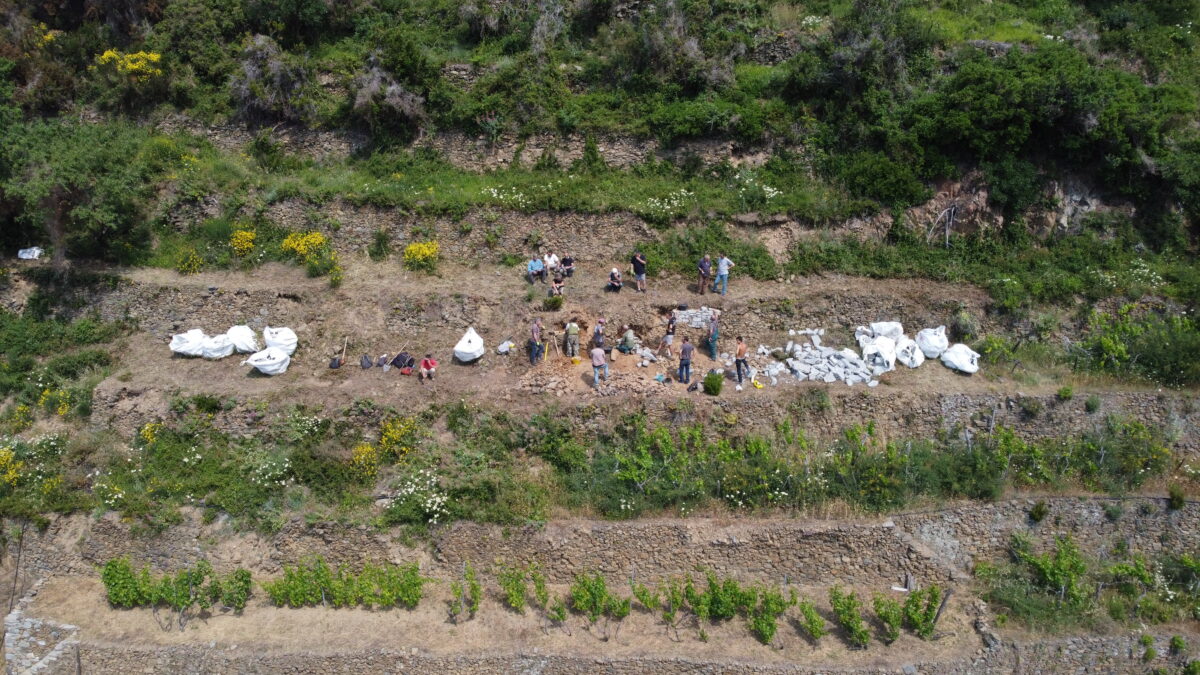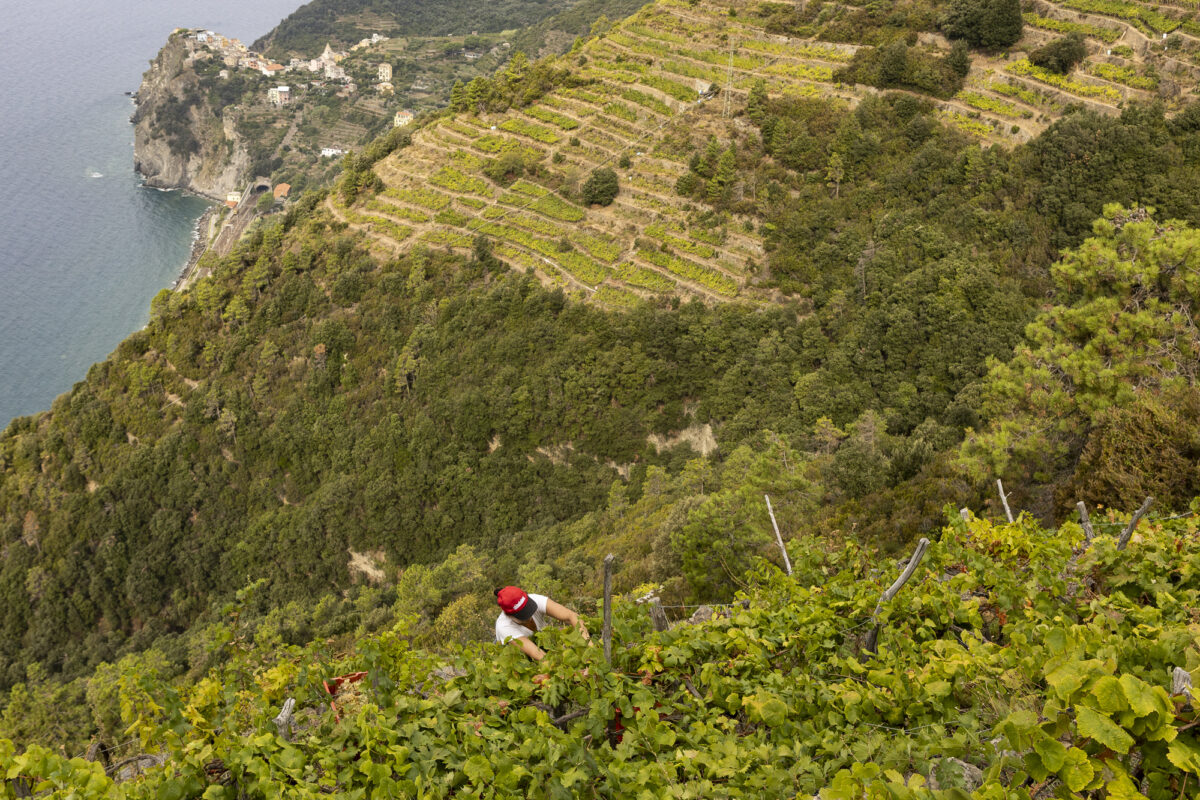The ancient art of dry stone walling, which varies from region to region depending on the different morphological conditions of the land, the type of stone encountered, is an age-old technique that testifies to the intimate relationship between humans and their natural environment. Its uses are many: in rural areas, low walls were used to demarcate property boundaries, enclose livestock and create terraces for cultivating uneven terrain.
This technique holds significant importance as it embodies the local community’s knowledge and traditional management of nature and the peculiarities of its cultural landscape. In fact, it is an integrated system, in which material and immaterial aspects are strongly connected, encompassing the traditional knowledge, skills and techniques handed down from generation to generation. It includes specific skills in the selection and adaptation of stones, as well as a deep knowledge of the local landscape and environment.
Nowadays, dry stone walls and terraced systems are increasingly recognized as versatile climate change adaptation options providing a sustainable solution for water management, flood prevention, landslide and avalanche control, soil retention, fertility enhancement, erosion and desertification mitigation, biodiversity enhancement, and the creation of favorable microclimates for agriculture. Consequently, dry stone walls and terraces can play a key role in addressing various environmental challenges and promoting sustainable practices in different areas.
For this reason, Green Heritage examined the case of dry stone walls in the Cinque Terre, a coastal region in Liguria (northwestern Italy) that includes five small villages (Monterosso al Mare, Vernazza, Corniglia, Manarola and Riomaggiore). Here the landscape is marked by terraces that extend up up to 350-450 meters above sea level. Agriculture has been an ancestral activity in the Cinque Terre, with the terraced landscape serving as a testament to over 1,000 years of human labor. Through the work of generations, the original wild shrubs and woods covering the slopes have been transformed into cultivated vineyards on terraces. The slopes lined with dry stone walls have not only served practical purposes but have also shaped a cultural landscape, creating a visually coherent and structured pattern that defines the identity of Cinque Terre. Indeed, terraced landscapes are imbued with the memories and traditions of the people who built and maintained them over the centuries, passing knowledge down through generations.
Due to its exceptional cultural landscape and naturalistic values, the Cinque Terre has held UNESCO World Heritage Site status since 1997, and has been designated as a National Park (Cinque Terre National Park) since 1999.
The efforts of the Cinque Terre National Park and the UNESCO Site Office (as of 2018, when it became fully operational) have played a key role in preserving the region’s tangible and intangible heritage. Initiatives from the National Park such as the LIFE P.R.O.S.I.T. project have organized forums aimed at fostering dialogue between park managers and farmers to tackle agricultural challenges. Moreover, the Park created the “Handbook for the construction of dry stone walls: guidelines for the maintenance of terracing in the Cinque Terre” and established a training program for dry stone walls building and maintenance in the context of the most recent LIFE-funded project STONEWALLSFORLIFE.
Here, the walls serve multiple purposes: they provide wind protection for some crops and act as barriers that facilitate the accumulation and infiltration of water into the coarse, permeable soil. The main local crops, vines and olives, are esteemed for their quality production, as evidenced by their PDO and PGI labels. However, due to the steep terrain, small agricultural plots are very difficult to reach and are served by monorails used to transport crops down the slopes. This land feature has prevented the development of modern agriculture, gradually leading to a decline in the number of farmers in the area. As farmland is abandoned, the construction and maintenance of terraces have gradually declined, putting their preservation at risk. Moreover, the area is significantly impacted by serious hydrogeological problems due to its unique geological and geomorphological features. The gradual abandonment of agricultural terraces exacerbates the overall stability of entire slopes, leading to increased occurences of wall crumbling and mass movements.
In addition to these challenges, in Cinque Terre climate change is emerging as a threat multiplier amplifying existing risks and vulnerabilities. According to climate projections, the Cinque Terre is expected to experience an increase in both the intensity of extreme precipitation and the frequency of rainy days. Therefore, urgent adaptation measures and conservation policies are needed.
Local communities are aware and actively addressing these challenges, as evidenced by community initiatives dedicated to the restoration and reconversion of terraced hillsides. Among them, the “Fondazione Manarola Cinque Terre,” was established in response to the 2011 flood event with the primary goal of recovering the terraced hillsides surrounding the village and promoting their cultivation by local farms. In recognition of their significance, dry stone walls have been recently integrated into the Climate Adaptation Plan of the National Park, thereby institutionalizing the crucial role of both intangible heritage and associated tangible assets in enhancing climate resilience. More broadly, community residents, civil society organizations, authorities, and experts agree that in order to restore and maintain terraced land and therefore adapt to climate change, it is necessary to reconvert the land to productive use to ensure the economic sustainability of place management. However, community representatives also aspire to strike a balance between the region’s agricultural and tourism vocations, advocating a more sustainable tourism and promoting the co-evolution of the tourism and agrifood sectors. This includes enhancing the promotion and appreciation of the region’s agricultural traditions, highlighting their role in maintaining terraced landscapes, promoting a slow and experiential tourism educating tourists on the history of the place and traditional activities, and highlighting lesser-known elements of the place, such as hiking trails to help alleviate tourist pressure on villages.
The condition of dry stone walls is a focal point of Italian agricultural policies. The National Strategic Plan for Rural Development 2007-2013 emphasized the importance of landscape conservation, with a specific focus on preserving existing features, such as dry stone walls, as agricultural and environmental measures aimed at soil protection. In addition, specific regional measures were implemented to support the reconstruction and conservation of dry stone walls on cultivated terraces, recognizing their role in maintaining the efficiency and integrity of the rural landscape. These measures, co-financed by the European Union under certain conditions, emphasize the value of terraces in agriculture, landscape conservation and hydrogeological stability.
Overall, the recognition of cultural heritage as a tool to address environmental changes gives new value and purpose to the preservation of the tangible and intangible elements of dry stone walls and terraced landscapes. Growing awareness of the importance of cultural heritage has sparked numerous community and institutional initiatives to transfer knowledge, preserve traditional practices, and restore terraces that have been neglected and abandoned over time. These initiatives demonstrate a renewed appreciation for the cultural and strategic value of dry stone walls and their role in shaping the identity and resilience of local communities. By actively engaging in the restoration and maintenance of terraces, communities not only preserve their physical structures but also revive the intangible aspects associated with these landscapes.
Credits for pictures
© Parco Nazionale delle Cinque Terre (photographers Emanuele Raso (1 and 2) and Jacopo Grassi (3)



